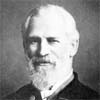| Displaying objects in museums [03] | . |
| . | Early in the development of exhibitions at The Natural History Museum, when its collections moved to South Kensington from the British Museum at Bloomsbury in 1881, the responsibility for the care of the objects whist on display was unclear. When the trustees of The British Museum (Natural History) created the post of Director in 1884, and appointed the first director, Sir William Henry Flower, the duties exceeded those of his predecessor Sir Richard Owen as Superintendent. As Conservator at the Royal Collage's Museum, prior to his appointment at the BM (NH), Flower had complete control over exhibits, but his duties at the NHM now included...
The trustees stated nothing specifically about the control of exhibits however. At this time exhibitions at the BM (NH) were the preserve of the scientific department that the collections were divided into. The departments of Botany, Geology, Mineralogy and Zoology each had their own exhibition galleries and repositories of specimens for research and associated libraries. Flower as Director took as his own the museums main hall to realise Sir Richard Owen’s vision of an 'index museum' to introduce these more specialised galleries around the Museum. |
.
|


Sir William Henry Flower. Director NHM: 1884-1898
| Displaying objects in museums [03] | . |